These two interviews with José Ángel Sánchez reveal some interesting insight into Sega Spain’s 16-bit strategy and the upcoming launch of the Saturn. The first interview comes from the May 1995 issue of Última Generación, the Spanish equivalent of Next Generation magazine. The second one originally appeared in the February 2000 issue of the Spanish Official Dreamcast Magazine.
Since January 1, 1995, José Ángel Sánchez is the CEO and General Director of Sega Consumer Products S.A., replacing Paco Pastor. A graduate of philosophy and Educational Science from Complutense University in Madrid, this 28 year-old Segovian has the difficult and passionate task of bringing the Saturn to the Spanish market ahead of the PlayStation and Nintendo Ultra 64.
Última: What is Sega and what is its claim to fame?
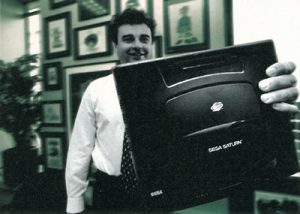
José Ángel Sánchez: Sega is the company that has triumphed in the video game world more than any other in the past three years, the company that has taken the most market share in that sector. We all know the of the supreme dominance of the Nintendo and its NES in Japan and the U.S. until about three or four years ago and what the arrival of the Mega Drive as a 16-bit console meant for the business. 1995 is a transition year, where the 16-bit consoles begin to be seen as systems in decline and where all expectations are placed on the new machines. Sega is an electronic entertainment company that seeks to capitalize on people’s leisure with its Family Parks and game rooms, as well as its presence in the home environment. Sega has leadership that is indisputable in the gaming market. What’s in play right now is the Saturn’s position in the market.
Última: What’s Sega’s market share right now compared to that of its competitors?
José Ángel Sánchez: According to Nielson data taken up to February of this year, and if we only count just the 16-bit market, Sega has 61.9% of the Spanish market with the Mega Drive, ahead of Nintendo’s 38.1% with the SNES. The difference is clear. Sega in Span has a largest market share in the world, even larger than in Japan.
Última: What does that data tell you?
José Ángel Sánchez: One thing that Sega has always done in our country is allot a high budget to R&D. Each year we conduct survey, and every time we do one we review afterward to determine the impact that it’s had. The survey done by Eco Consulting in February asked 600 kids what they thought of Sega and Nintendo. Aside from the question that asked, “Which brand has better games?” Sega beat Nintendo regarding the most advanced technology, which company was the leader, best console, best advertising, and overall preference.
Última: Let’s talk about the Mega CD. It must be counterproductive for the product to be left behind in just two days before the announcement of the new machines.
José Ángel Sánchez: The Mega CD marked the arrival of CD-ROM technology to video games, and realistic games, like Night Trap and Tomcat Alley have reached consumers thanks to Sega’s development of the technology. It’s true that the release of the Mega CD hasn’t been as brilliant as one might expect, but it hasn’t been as much because the market has evolved too rapidly as much as it’s been because Sega has had to allot its R&D to new projects, especially the Saturn.
Última: Isn’t it the same with the 32X?
José Ángel Sánchez: it’s different. The 32X represents an important advancement regarding the 16-bit consoles. It’s 40 times faster than the Mega Drive. It still hasn’t shown all that it can do. By the end of this year, we’ll release Virtua Fighter and probably a great soccer game.
Última: Is there any real third party support for the 32X? It seems that that hope has dissipated dangerously.
José Ángel Sánchez: Third party companies haven’t been receptive because they’re all wrapped up in development for the new consoles. Some of them have begun making games, and I know there will be some important titles out by year’s end. We can’t say that there’s been massive support for the 32X by software companies, so Sega has supported it with its own games. One of the keys to its future will be Virtua Fighter. The 32X is the only way to upgrade an install base of 600,000 Mega Drives [in Spain] to a technology that is truly 32-bits. If Sega is able to surround it with quality software, it will have a chance next year.
Última: If Sega is going to support the 32X as you say, where does the Mega CD stand in all of this?
José Ángel Sánchez: Sega Spain is going to release the same number of games for the Mega CD as for the Mega Drive this year, so the consumer who already bought a Mega CD and the ones who do so now won’t feel abandoned. We’re talking about amazing games like Striker CD and Fahrenheit. The consumer who has to choose between a 32X and the Mega CD will probably be more attracted to the former’s launch line. The really privileged gamer is the one who owns both because we’re going to release games on CD for the 32X that are spectacular.
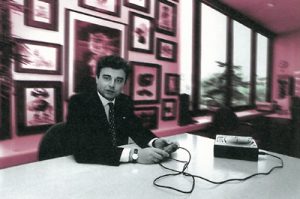
Última: Will the Mega Drive continue to be the console with the most games?
José Ángel Sánchez: Exactly. Just think that when Sega develops a game for the Mega Drive, it will be making versions for the Mega CD and 32X as well.
Última: How do you think the market will behave? Will we see the same sales numbers we saw in the 1991 and 1992 holiday seasons?
José Ángel Sánchez: I think the new consoles represent a wider concept of what a video game is. Saturn is compatible with Video CD through an MPEG card. The kind of control allowed over images and sound was indispensable just a short time ago. Saturn is much more than just a gaming machine. The new consoles reaffirm the idea that video games are not a waste of time but a leisure activity that has established itself worldwide forever, like music or movies.
Última: But will the market be what it once was, or will things change?
José Ángel Sánchez: Everything depends exclusively on pricing. Can the new consoles establish themselves in the market at the same numbers we saw in 1992? From my perspective, there’s no doubt they can. The kind of gaming experience offered by Daytona USA is so different from what we’ve known until now that it can position itself in the market at that level and even go farther. Whether that happens or not is purely an issue of pricing.
Última: Why hasn’t Sega joined with its coin-op department until now?
José Ángel Sánchez: It’s true and I don’t know why. Perhaps it’s because the Saturn is already capable of reproducing games made for coin-op.
Última: Nintendo has stated that its console will cost $250 (35.00 pesetas) and will use cartridges.
José Ángel Sánchez: I don’t have information about what price Nintendo will sell at. It looks like the U.S. will be at $250, but there’s no confirmation of what will happen in Europe. In fact, there’s an explicit statement that there is no official price for the Old World (Europe). I have the feeling that Nintendo has the obligation to sell at that price if it makes a cartridge-based machine.
Última: What opinion do you have about Nintendo opting to stick with cartridges, a format more expensive to produce than CDs?
José Ángel Sánchez: I think that behind it all is a separation of strategies. Nintendo wants to create a large installed userbase with low cost hardware in a short amount of time, and then concern itself with the cartridge sales market, which has a lot of cost effectiveness issues. The cartridge is a deceitful format in the sense that it costs a lot to manufacture and it’s impossible to sell it at an affordable price. Sega and Sony, in contrast, have chosen another path: create a userbase in the time it takes to create a profitable business, based on the sales of CDs, where the manufacturing costs are much less. This strategy will let us sell high quality games at a competitive price. Because of that, Nintendo is forced to sell its hardware at a cheaper price.
Última: Rafael Martínez, Nintendo Spain’s Product Manager, confirmed in an interview with Última Generación that if Sega launches the same Saturn we’ve seen in Japan, it will stay in third place. Do you agree?
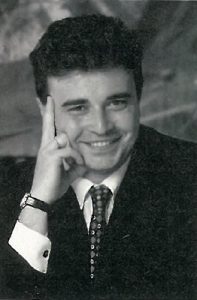
José Ángel Sánchez: At this stage of the game, it’s indisputable that what make consoles good or bad are the games and not their technological specifications.
This market has been around a few years now, and we’ve all seen how far the strength of a launch can go to sell a console. When the consumer buys a machine, they buy certain game possibilities. We’re no longer in the market of “this machine’s bits or the polygons that this other machine can generate” – that’s an exaggerated simplification of the market. The machine that can provide the most incredible gaming experiences will be the one that controls the market. I think the one that’s best positioned for the market for the next few years is the one that has Daytona USA and Virtua Fighter. Technical specifications are just another bullet point, but they’re not an end in itself. The end is the game, not the polygons or number of megabytes.
Última: Does Sega put opportunity before the final quality of its products?
José Ángel Sánchez: It’s not exactly that approach. I know nothing of Nintendo’s console, aside that it’s going to be 64-bits and there are a bunch of companies developing for it, but at the moment I haven’t seen anything. I don’t even know if it’ll ever come to market. You can’t say right now if it will better or worse.
That’s why, it’s not that Sega puts timing ahead of quality in its launches. It’s simply that the Saturn’s existence is a fact and the existence of the Ultra 64 is an act of faith.
Última: In the last few years, Sega has bombarded Spanish stores with a flood of Mega Drive games that, in some cases, didn’t meet minimum levels of quality. Will this continue to be the case or will you be more selective?
José Ángel Sánchez: We’ll be more selective. This year, we’ve incorporated into our plans a drastic reduction in titles to truly offer those games that surpass that quality threshold. So far, we’ve released a great quantity of games to give consumers as many choices as possible. This has greatly helped us to learn tendencies.
Última: Does Sega have any plans to open more theme parks in Spain?
José Ángel Sánchez: Yes, they’re called “Sega Family.” In Spain, Sega will construct two types of parks: Family Entertainment Centers, which will be done through investors, and theme parks, which are internal company projects.
Última: When will we be able to enjoy these parks?
José Ángel Sánchez: It’s hard to say because Spanish legislation is a bit complicated in this regard; Bureaucracy is tough. The only thing we can confirm is that we’ll see the first family entertainment centers before the year’s out, though I can’t go into more details. Sega of Japan has high hopes for them.
Última: Is Sega convinced that the Saturn will continue the company’s dominance?
José Ángel Sánchez: Our current dominance isn’t questionable; It’s derived from verifiable data. It’s indisputable. Regarding future dominance, I have the feeling that what’s happening in Japan will also happen in Spain. Sega is positioning itself in the market to be the indisputable 32-bit leader.
Última: Where do you see the other consoles?
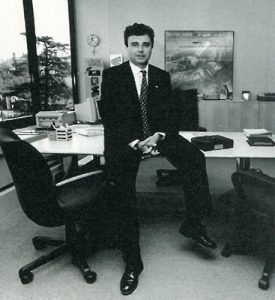
José Ángel Sánchez: The investment Sony has announced and the expectations it’s creating with the PlayStation will probably bear fruit. We have always been a humble company; We don’t like to be arrogant. There will be room in the future for everyone, but Sega is the company with a clear history of leadership and it will use all of its experience as a video game company that lives for video games. We have to show that we’re not here by chance. We’re a company that needs the Saturn to be successful in the next three years, and we intend to guarantee it.
Última: Are the sales of 16-bit consoles slowing down in anticipation of the new machines?
José Ángel Sánchez: No. It’s curious that it’s not happening. This will be a year where the 16-bit consoles will sell a lot, fundamentally because of pricing.
Última: Try and tell us what you see in the future.
José Ángel Sánchez: To guarantee the future, it’s essential to use the CD format. The consoles that don’t support that format may be find themselves with a handicap that will make them unsavable in 1996. Among the consoles that use CD-ROM, I think the one that can offer the biggest names will be triumphant. Exclusive software will take on a fundamental importance. In both cases, the Saturn has everything to win.
* * *
In this interview, Sega Spain’s General Director, José Ángel Sánchez, talks about the Dreamcast’s launch in Spain and Sega’s plans to bring online gaming to Europe. Though short, it offers some great insight about the console’s debut in Spain and how Europeans were taking to Sega’s Dreamarena online network.
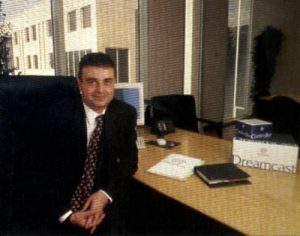 ODC: The Christmas season is over. Can you tell us how things went for Sega?
ODC: The Christmas season is over. Can you tell us how things went for Sega?
José Ángel Sánchez: As you know, Sega’s wish list for the Three Wise Men was quite ambitious, and we’re very satisfied to say that our wishes have been granted. We launched our console this past October 14, and in only two months, the Dreamcast has found success unprecedented in the launch phase of a console. We’re very satisfied with the results we’ve obtained thus far.
ODC: Do you have any sales data for Spain?
José Ángel Sánchez: Yes. Our objective was to move 100,000 Dreamcasts in the Spanish market, and we’ve done it.
ODC: What’s your perception about the Spanish public’s reception of the console?
José Ángel Sánchez: The Dreamcast has become a very sought after leisure product, one that the public has come to by two different routes. We have the “lifelong” player who wants a cutting-edge product that will offer a new gaming experience, and we have the customer who’s come to it because of connectivity, the universe of possibilities that a free Internet connection can offer.
I think that as a video game console, the Dreamcast is a known product, but there are still people who are wary about the possibility of accessing the Internet through their televisions and ask what Dreamarena is or if they can navigate with their consoles. As you know, Dreamarena is the exclusive Dreamcast website, and of course, it can access anywhere on the web.
ODC: Regarding the Internet, do you know what percentage of people who own a Dreamcast surf the web with it?
José Ángel Sánchez: We’re very satisfied that 35% of people who have bought a Dreamcast in Europe have accessed the Internet through our website [Dreamarena].
ODC: Which game has sold the best? Have there been any surprises?
José Ángel Sánchez: Sonic Adventure, Sega Rally, and of course, Soul Calibur have become true phenomena.
ODC: Out of curiosity, what’s your favorite game?
José Ángel Sánchez: I’ve had the chance to try Metropolis Street Racer before its release and it has me hooked.
ODC: What does Sega Spain expect from the year 2000, which has just begun?
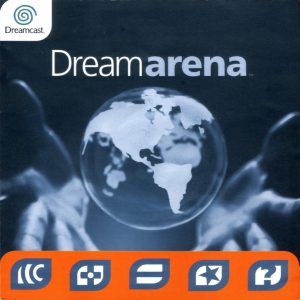 José Ángel Sánchez: This year is very special for us, as we will soon celebrate our first 10 years in Spain, specifically on February 14. Our wish is to continue offering new experiences that satisfy our customers and that many of our online developments become a reality, like online play. These are projects that we are convinced will continue the Dreamcast’s success.
José Ángel Sánchez: This year is very special for us, as we will soon celebrate our first 10 years in Spain, specifically on February 14. Our wish is to continue offering new experiences that satisfy our customers and that many of our online developments become a reality, like online play. These are projects that we are convinced will continue the Dreamcast’s success.
ODC: Can you give us any hint about the approximate release date of Shenmue? Will it be localized?
José Ángel Sánchez: Shenmue will arrive in Spain before the end of the year, but it’s too early to talk about a final release date. Regarding the localization, I can assure you that we’re not going to release it in Japanese…
ODC: Can we say that this will be the year of online gaming?
José Ángel Sánchez: Without a doubt. We’re betting on opening a window to connectivity, and since the start online gaming has been one of our priorities. But every new step takes time. We’ve built a European chat and email network through our website, which was online since the console’s launch. 2000 will be the year of online gaming in Europe.

Recent Comments